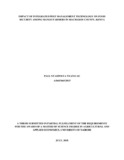Impact of integrated pest management technology on food security among mango farmers in Machakos county, Kenya.

View/
Date
2018-07Author
Nyang`au, Paul N
Type
ThesisLanguage
enMetadata
Show full item recordAbstract
Mango (Mangifera indica) is one of the leading tropical fruits grown in Kenya and is ranked third after banana and pineapples in terms of acreage and total production volume. However, production has fallen below consumption due in part to fruit fly (Bactrocera invadens) infestation. About 40 percent of annual mango production in Kenya estimated at US$ 32 million, is lost due to direct damage of fruit flies. In an effort to improve production, the International center for Insect Physiology and Ecology (ICIPE) has developed a set of Integrated Pest Management (IPM) technologies aimed at controlling fruit fly infestation in mangoes. However, the impact of these technologies on the food security are not well understood.
This study evaluated the impact of IPM technology for mango fruit fly control on food availability and accessibilty among 600 mango farmers in Mwala and Kangundo sub-Counties selected using a stratified sampling procedure. A seven-day recall was used to elicit Per Capita Calorie Intake while a 30-day recall was used to measure household dietary diversity. To evaluate the impact of IPM on food security the difference-in-difference method (DD) was used.
The results indicate that 67 percent of IPM participants in Mwala and 75 percent of non-participants in Kangundo were food secure as they had attained the 2,250 Kcal threshold recommended by the Kenya National Bureau of Statistics (KNBS). The OLS regression results show that the IPM technology had a positive impact on per capita calorie intake but not on the quality of food intake (HDDI) estimated by the poison regression. This suggests that farmers using IPM technology benefit from income gains, and higher incomes improve the economic availability to food but not food access. The study recommends that the government should promote IPM technology for the control of mango fruit fly as it is likely to improve the food security of smallholder farmers
Publisher
University of Nairobi
